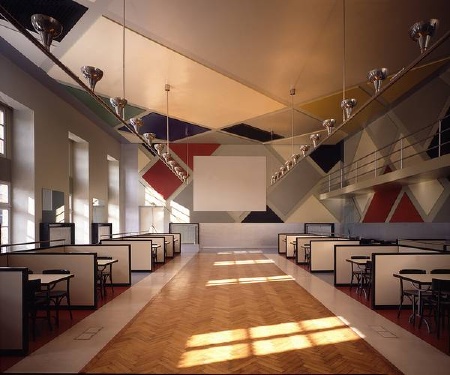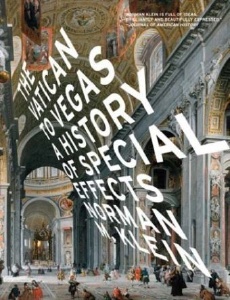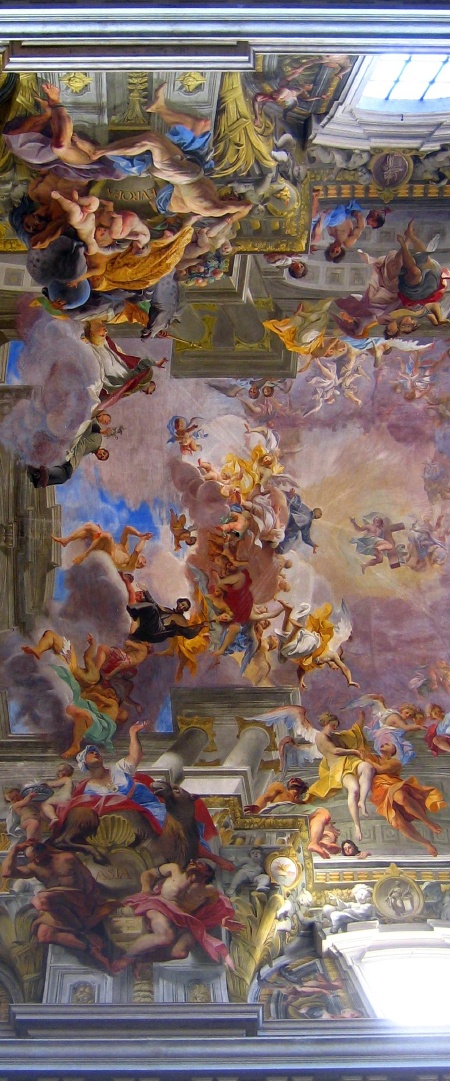Yet another new webservice coming up, this one called ‘Fotowoosh‘ (via InternetActu). But these guys write:
“Fotowoosh will forever change the way you think of your pictures. We live in a multidimensional world- it’s time to break out of the one or two dimensions that media and technology have locked us into for so long. Let’s dive in and look around. Let’s create worlds where there once were barriers.”
The era of gentlemanly understatement has been over for some time, but I was sort of puzzled by this claim of total spatial liberation for a service that transforms a static flat image into an interactive flat image; however interesting that may be in itself.
It reminded me of two things:

the reconstructed ‘Cine-Dancing’, designed by Theo van Doesburg in 1928.
first a text I wrote in 2004 as an introduction to the ‘4d‘ event I curated, a long quote from that text:
“A bit less than a century ago there was much ado about the fourth dimension. Mystics and mathematicians were speculating about an extra dimension of space, at right angles to the three dimensions height, breadth and depth already familiar to us from daily life. By way of the fourth dimension spiritists were promising access to deceased loved ones. The new physics after Einstein considered time as a fourth dimension, suggesting stunning interactions between time and space. This cloud of ideas was a great source of inspiration for the new language of abstract art that came into existence in this period, and was food for the thoughts of artists such as Boccioni, Malevitch and Van Doesburg. They were not necessarily very well informed about the latest scientific developments of their time, but in their own work they found characteristics that seemed to be well covered by the new scientific terminology.
These phenomena around the fourth dimension share one common idea: the vision of a radically different point of view from which new connections suddenly come to light. The idea of a new dimension of some kind became a seed around which all kinds of notions of change and renewal could grow, technological as well as artistic and social. An essentially geometrical concept was suddenly endowed with great spiritual and emotional connotations. These thoughts found their most explicit formulation in 1936 in the otherwise rather obscure Manifeste Dimensioniste. This manifesto was written in Paris by the Hungarian poet Károly Sirató, and signed by about twenty artists, amongst them great names such as Moholy-Nagy, Calder, Duchamp, Kandinsky and Arp. The manifesto wanted to encourage the ‘dimensionist’ tendency in the arts, the tendency which pushed literature to leave the line in order to conquer the graphic page, in which painting breaks out of the plane and becomes three-dimensional, and where sculpture leaves the ‘closed and dead’ space of three dimensions in order to conquer the new, four-dimensional and kinetic space. And finally the manifesto announces a new ‘cosmic and truly four-dimensional’ art form: the ‘evaporation of sculpture, a gaseous art without solid matter as material, where the spectator is no longer an outside observer, but where he himself, with the synthesis of all his senses, is both the center and the subject of art’.”

and I just started reading “The Vatican to Vegas, a History of Special Effects”, by Norman M. Klein, a great book with a lot of attention for statements implied by ‘scripted spaces’ and the politics going on behind the scenes. Some quotes that seem appropriate, when he is talking about the famous ceiling by Pozzo:
“Thus, painted quadratura may falsify a flat ceiling, give it fake domes and cupolas. The trompe l’oeil and anamorphosis may distort these even further. But the sum effect was proof of divine right, ontology by way of special effects. The term used the most often to defend this proof was Neoplatonic. According to Neoplatonic ideology, no matter how lustful these hoaxes appeared to be, they were not sinful, or excessive. They were, in fact, the scar left by the blinding light of God. The were chaste and hierarchical. After all, if revelation as a visual trick can feel this eloquent, what would the true immersion with God feel like ? How ecstatic the final becoming, the final blindness.
… (snip) …
As a moral philosophy, special effects preaches imaginary violence or imaginary excess. For example, I understand that there is a special-effects film in production about millions of people collectively faking an orgasm together. It is a stronger version of Stanley Kubrick’s hollow-masqued orgy in Eyes Wide Shut. Sade-ian libertines moisten each other underneath a “floating” Baroque ceiling. In the end, not much happens, but with a lot of noise.”

a small part of the ceiling of the Church of Sant’Ignazio, by Andrea Pozzo
